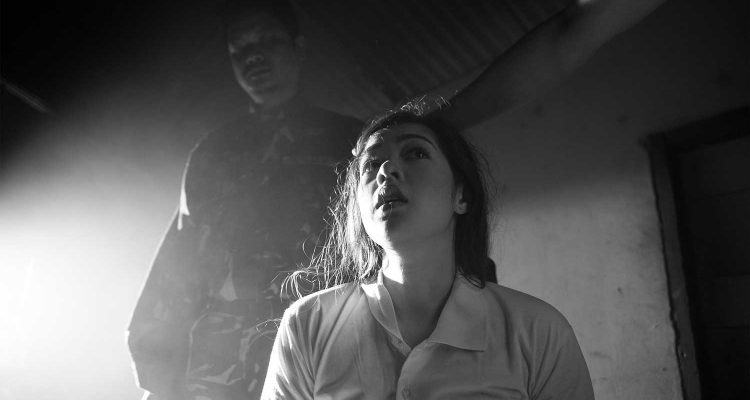No director embodies the split between the attention spans of commercial audiences and film festival-goers quite like Lav Diaz. The Filipino auteur, who often only does one go-for-broke take for each shot, has cranked out as much as 12 hours of cinema in a year’s span. That might be one monumental work, like 2004’s 10-hour “Evolution of a Filipino Family” or split across two features, such as 2016’s “A Lullaby to a Sorrowful Mystery” (eight hours) and the Golden Lion-winning “The Woman Who Left” (four hours). Diaz returns to the Competition of the Berlin International Film Festival with his 234-minute black-and-white “rock opera” “Season of the Devil.” It’s a mesmerizing film that towers over the rest of the Berlinale selection with its uncompromising style and spirited, scathing political criticism.
“Season of the Devil” kicks off in the late ‘70s, after dictator President Marcos institutes a national militia to combat so-called communist dissidents. The effects of this edict play out in the rural town of Gilbon, where militia leaders Ahas (Joel Saracho) and Tenyente (Hazel Orencio) scheme to consolidate power. They achieve this by preying upon the supernatural fears of the populace, accrediting the brutal murders to folkloric spirits. Across the country, poet Hugo Haniway (Piolo Pascual) is separated from his wife Lorena (Shaina Magdayao) when she leaves to set up a medical practice in the suffering Gilbon. Hugo is forced to deal with his ghosts both literally and figuratively, grappling with his guilt and his artistic inertia.
As for the music itself, don’t expect to be spinning the soundtrack on Spotify, but audiences can rest assured that the lyrical quality — and the singing ability of the cast — are much stronger than what Bruno Dumont brought to his historical musical, “Jeannette.” While Diaz’ songbook has more in common with Jacques Demy’s arthouse tack than Broadway (sometimes sung dialogue, sometimes a complete song and all the poetry it entails) there are no extra-diegetic instruments employed to round out the sound. Every so often other players in the scene will step in as backing vocalists. The effect is often humorous but turns unsettling when a villager adds to a militant’s tune, coming across as an act of fearful submission. Diaz himself takes credit for composing the music, in addition to writing, editing and producing the film; a residency at the Harvard Radcliffe Institute gave the filmmaker a space to develop this entirely new dimension to his filmmaking practice.
Sight-unseen, one is tempted to write off “Season of the Devil” as the equivalent of a musical episode in Diaz’ filmography. However, the genre tool is no gimmick — the singsong dialogue feeds into the spiritual tug-of-war playing out between the militia and the villagers. Just like the tales of mythical creatures, music is a communal tradition that becomes perverted by Ahas, Tenyente and their goons. As a result, the battle for a free Philippines isn’t only waged in the lyrics, it’s woven into the fabric of the film itself with each and every note. The indispensability of art to the political struggle is fleshed out further in the character of Hugo, his writers’ block intertwined with the national climate of fear and oppression.
The portrayal of the primary antagonists of “Season of the Devil” are admittedly problematic, variably depicted as monstrous, disfigured or queer. The director has shown the capacity for nuanced representation with the dynamic trans character in “The Woman Who Left,” but here seems to have taken a more archetypal approach in his casting. The selection of Filipino matinee idols Pascual and Magdayao in the roles of Hugo and Lorena makes the distinction between the heroes and the villains even more visually pronounced.
If courting distribution isn’t enough of a challenge for Diaz’ endurance tests, “Season of the Devil” promises to keep projectionists on their toes with its unconventional 1.50:1 aspect ratio. Wide lenses are used throughout to distort the black-and-white compositions and give the film a consistent aesthetic. Serving as his own editor, Diaz doesn’t cut around space or magnify individual solos with close-ups, sticking to his customary long takes and deep staging. This signature cadence slows the pace to the local speed of life. At the same time, the static framing of the sequence shots often ensnare our protagonists in the militia’s trap and seals their fates.
Lav Diaz dedicates “Season of the Devil” to “all the victims of martial law,” clarifying the target of his harrowing musical’s unflinching criticism. On more than one occasion does Ahas label the villagers’ dead family members as drug dealers, drawing parallels to current President Duterte’s brutal war on drugs that has claimed thousands of lives. Its a ballsy and pointed critique by a director who steeps all of his work in the singular culture and traumatic history of his country. Diaz’ call-to-arms to artists speaks to the present just as it depicts a terrible period in the Philippines’ past. “Season of the Devil” is still a grueling, advanced-level watch, but one that delivers beauty and horror in equal measure. [A-]
Browse through all our coverage of the 2018 Berlin International Film Festival by clicking here.

